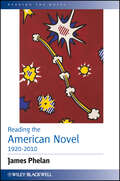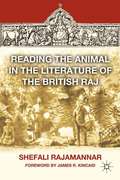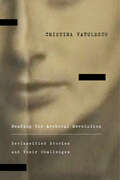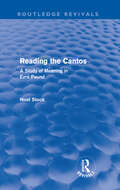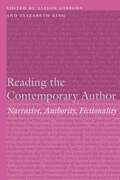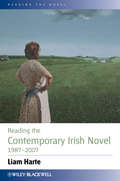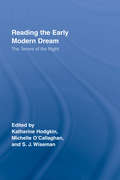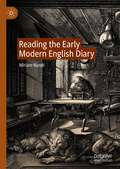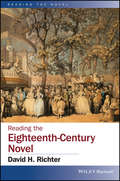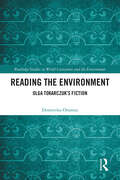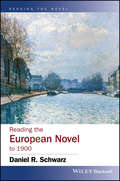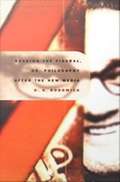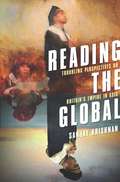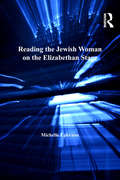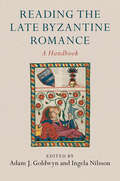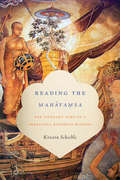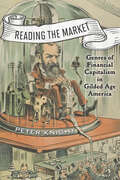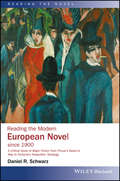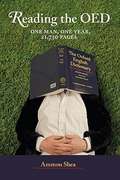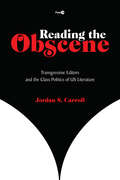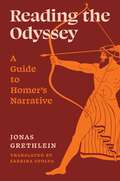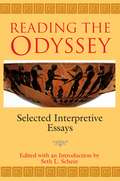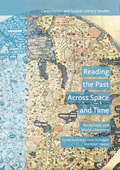- Table View
- List View
Reading the American Novel 1920-2010
by James PhelanThis astute guide to the literary achievements of American novelists in the twentieth century places their work in its historical context and offers detailed analyses of landmark novels based on a clearly laid out set of tools for analyzing narrative form.Includes a valuable overview of twentieth- and early twenty-first century American literary history Provides analyses of numerous core texts including The Great Gatsby, Invisible Man, The Sound and the Fury, The Crying of Lot 49 and FreedomRelates these individual novels to the broader artistic movements of modernism and postmodernismExplains and applies key principles of rhetorical readingIncludes numerous cross-novel comparisons and contrasts
Reading the Animal in the Literature of the British Raj
by Shefali RajamannarThis book explores representations of animals during British rule in India - the tigers, elephants, boars, furs, and feathers that so often all but obscured the human beneath and behind them, and that were such an important part of creating and maintaining the hierarchies that were the cornerstones of colonialism. The book exists on two levels: one offers a sophisticated view of how power and oppression work within constellations of species, race, class, gender, and nationhood, and the other is a deeply suggestive meditation on our humanness and how we locate it within a spectrum of relations. Drawing on a range of texts (hunting narratives, stories, poetry, novels, photographs, journals, paintings, and cartoons) the argument builds with a lucid and beautifully unintrusive feel for the telling example.
Reading the Archival Revolution: Declassified Stories and Their Challenges (Square One: First-Order Questions in the Humanities)
by Cristina VatulescuThe opening of classified documents from the Soviet era has been dubbed the "archival revolution" due to its unprecedented scale, drama, and impact. With a storyteller's sensibility, Cristina Vatulescu identifies and takes on the main challenges of reading in these archives. This transnational study foregrounds peripheral Eastern European perspectives and the ethical stakes of archival research. In so doing, it contributes to the urgent task of decolonizing the field of Eastern European and Russian studies at this critical moment in the region's history. Drawing on diverse work ranging from Mikhail Bakhtin to Tina Campt, the book enters into broader conversations about the limits and potential of reading documents, fictions, and one another. Pairing one key reading challenge with a particularly arresting story, Vatulescu in turn investigates Michel Foucault's traces in Polish secret police archives; tackles the files, reenactment film, and photo albums of a socialist bank heist; pits autofiction against disinformation in the secret police files of Nobel Prize laureate Herta Müller; and takes on the digital remediation of Soviet-era archives by analyzing contested translations of the Iron Curtain trope from its 1946 origins to the current war in Ukraine. The result is a bona fide reader's guide to Eastern Europe's ongoing archival revolution.
Reading the Bible Again for the First Time: Taking the Bible Seriously but Not Literally
by Marcus J. BorgOne of the vital challenges facing thoughtful people today is how to read the Bible faithfully without abandoning our sense of truth and history. Reading the Bible Again for the First Time provides a much-needed solution to the problem of how to have a fully authentic yet contemporary understanding of the scriptures. Many mistakenly believe there are no choices other than fundamentalism or simply rejecting the Bible as something that can bring meaning to our lives. Answering this modern dilemma, acclaimed author Marcus Borg reveals how it is possible to reconcile the Bible with both a scientific and critical way of thinking and our deepest spiritual needs, leading to a contemporary yet grounded experience of the sacred texts. This seminal book shows you how to read the Bible as it should be examined -- in an approach the author calls "historical-metaphorical." Borg explores what the Scriptures meant to the ancient communities that produced and lived by them. He then helps us to discover the meaning of these stories, providing the knowledge and perspective to make the wisdom of the Bible an essential part of our modern lives. The author argues that the conventional way of seeing the Bible's origin, authority, and interpretation has become unpersuasive to millions of people in our time, and that we need a fresh way of encountering the Bible that takes the texts seriously but not literally, even as it takes seriously who we have become. Borg traces his personal spiritual journey, describing for readers how he moved from an unquestioning childhood belief in the biblical stories to a more powerful and dynamic relationship with the Bible as a sacred text brimming with meaning and guidance. Using his own experience as an example, he reveals how the modern crisis of faith is itself rooted in the misinterpretation of sacred texts as historical record and divine dictation, and opens readers to a truer, more abundant perspective. This unique book invites everyone -- whatever one's religious background -- to engage the Bible, wrestle with its meaning, explore its mysteries, and understand its relevance. Borg shows us how to encounter the Bible in a fresh way that rejects the limits of simple literalism and opens up rich possibilities for our lives.
Reading the Cantos: A Study of Meaning in Ezra Pound (Routledge Revivals)
by Noel StockFirst published in 1967, this is a study which tackles the central problem of meaning, within Ezra Pound's The Cantos. It deals with the question of important critical issues, as well as of interpretation and understanding. Students of modern poetry will derive great benefit from this vigorous and lucid analysis of Pound's masterpiece. Noel Stock's finding is radical: that The Cantos is not a really a poem at all, but rather notes towards a poem. It is a collection of fragments of varying quality - some of extraordinary power and beauty - but in no sense formed into a work of art.
Reading the Contemporary Author: Narrative, Authority, Fictionality (Frontiers of Narrative)
by Elizabeth King Alison GibbonsReaders, literary critics, and theorists alike have long demonstrated an abiding fascination with the author, both as a real person—an artist and creator—and as a theoretical concept that shapes the way we read literary works. Whether anonymous, pseudonymous, or trending on social media, authors continue to be an object of critical and readerly interest. Yet theories surrounding authorship have yet to be satisfactorily updated to register the changes wrought on the literary sphere by the advent of the digital age, the recent turn to autofiction, and the current literary climate more generally. In Reading the Contemporary Author the contributors look back on the long history of theorizing the author and offer innovative new approaches for understanding this elusive figure. Mapping the contours of the vast territory that is contemporary authorship, this collection investigates authorship in the context of narrative genres ranging from memoir and autobiographically informed texts to biofiction and novels featuring novelist narrators and characters. Bringing together the perspectives of leading scholars in narratology, cultural theory, literary criticism, stylistics, comparative literature, and autobiography studies, Reading the Contemporary Author demonstrates that a variety of interdisciplinary viewpoints and critical stances are necessary to capture the multifaceted nature of contemporary authorship.
Reading the Contemporary Irish Novel 1987 - 2007 (Reading the Novel)
by Liam HarteReading the Contemporary Irish Novel 1987–2007 is the authoritative guide to some of the most inventive and challenging fiction to emerge from Ireland in the last 25 years. Meticulously researched, it presents detailed interpretations of novels by some of Ireland’s most eminent writers. This is the first text-focused critical survey of the Irish novel from 1987 to 2007, providing detailed readings of 11 seminal Irish novels A timely and much needed text in a largely uncharted critical field Provides detailed interpretations of individual novels by some of the country’s most critically celebrated writers, including Sebastian Barry, Roddy Doyle, Anne Enright, Patrick McCabe, John McGahern, Edna O’Brien and Colm Tóibín Investigates the ways in which Irish novels have sought to deal with and reflect a changing Ireland The fruit of many years reading, teaching and research on the subject by a leading and highly respected academic in the field
Reading the Early Modern Dream: The Terrors of the Night (Routledge Studies In Renaissance Literature And Culture Ser. #7)
by Katharine HodgkinDreams have been significant in many different cultures, carrying messages about this world and others, posing problems about knowledge, truth, and what it means to be human. This thought-provoking collection of essays explores dreams and visions in early modern Europe, canvassing the place of the dream and dream-theory in texts and in social movements. In topics ranging from the dreams of animals to the visions of Elizabeth I, and from prophetic dreams to ghosts in political writing, this book asks what meanings early modern people found in dreams.
Reading the Early Modern English Diary
by Miriam NandiReading the Early Modern Diary traces the historical genealogy, formal characteristics, and shifting cultural uses of the early modern English diary. It explores the possibilities and limitations the genre held for the self-expression of a writer at a time which considerably pre-dated the Romantic cult of the individual self. The book analyzes the connections between genre and self-articulation: How could the diary come to be associated with emotional self-expression given the tedium and repetitiveness of its early seventeenth-century ancestors? How did what were once mere lists of daily events evolve into narrative representations of inner emotions? What did it mean to write on a daily basis, when the proper use of time was a heavily contested issue? Reading the Early Modern Diary addresses these questions and develops new theoretical frameworks for discussing interiority and affect in early modern autobiographical texts.
Reading the Eighteenth-Century Novel
by David H. RichterReading the Eighteenth-Century Novel is a lively exploration of the evolution of the English novel from 1688-1815. A range of major works and authors are discussed along with important developments in the genre, and the impact of novels on society at the time. The text begins with a discussion of the “rise of the novel” in the long eighteenth century and various theories about the economic, social, and ideological changes that caused it. Subsequent chapters examine ten particular novels, from Oroonoko and Moll Flanders to Tom Jones and Emma, using each one to introduce and discuss different rhetorical theories of narrative. The way in which books developed and changed during this period, breaking new ground, and influencing later developments is also discussed, along with key themes such as the representation of gender, class, and nationality. The final chapter explores how this literary form became a force for social and ideological change by the end of the period. Written by a highly experienced scholar of English literature, this engaging textbook guides readers through the intricacies of a transformational period for the novel.
Reading the Environment: Olga Tokarczuk’s Fiction (Routledge Studies in World Literatures and the Environment)
by Dominika OramusReading the Environment: Olga Tokarczuk’s Fiction aims at analysing the dynamics of reading fiction in the context of accelerating climate change. This volume proposes an environment-oriented model of reading and applies it to a well-defined corpus—all existing English translations of Olga Tokarczuk’s fiction. These are: Primeval and Other Times, House of Day, House of Night, Drive Your Plow Over the Bones of the Dead, Flights, The Books of Jacob and The Empusium, removed from the immediate cultural context of a single author, these novels give a representative sample of contemporary literature read by Anglophone people of diverse national backgrounds who live in different localities, but share one endangered planet, whether they realise it or not. The book charts five ways in which our reading protocols have shifted: the way of interconnectedness, the way of naturecultures, the way of sympoiesis, the way of Earth Island, and the way of the beginning of the Anthropocene. This book is written for an academic audience (postgraduates, researchers and academics) specialising in Environmental Humanities, Ecocriticism, World Literature, Postmodern Literature and Climate Fiction.
Reading the European Novel to 1900: A Critical Study Of Major Fiction From Cervantes' Don Quixote To Zola's Germinal (Reading the Novel)
by Daniel R. Schwarz"Schwarz's study is chock full of judicious evaluation of characters, narrative devices, ethical commentary, and helpful information about historical and political contexts including the role of Napoleon, the rise of capitalism, trains, class divisions, transformation of rural life, and the struggle to define human values in a period characterized by debates between and among rationalism, spiritualism, and determinism. One experiences the pleasure of watching a master critic as he re-reads, savors, and passes on his hard-won wisdom about how we as humans read and why.Daniel Morris, Professor of English, Purdue University Written by one of literature's most esteemed scholars and critics, Reading the European Novel to 1900 is an engaging and in-depth examination of major works of the European novel from Cervantes' Don Quixote to Zola's Germinal. In Daniel R. Schwarz's inimitable style, which balances formal and historical criticism in precise, readable prose, this book offers close readings of individual texts with attention to each one's cultural and canonical context. Major texts that he discusses: Cervantes' Don Quixote; Stendhal's The Red and the Black and The Charterhouse of Parma; Balzac's Père Goriot; Flaubert's Madame Bovary and Sentimental Education; Dostoevsky's Notes from Underground, Crime and Punishment, and The Brothers Karamazov; Tolstoy's War and Peace and Anna Karenina; and Zola's Germinal. Schwarz examines the history and evolution of the novel during this period and defines each author's aesthetic, cultural, political, and historical significance. Incorporating important pedagogical suggestions and the latest research, this text provides accessible and lucid discussion of the European novel to 1900 for students, teachers, and general readers interested in the evolution of the novelistic form.
Reading the Figural: Or, Philosophy After the New Media
by D. N. RodowickIn Reading the Figural, or, Philosophy after the New Media D. N. Rodowick applies the concept of "the figural" to a variety of philosophical and aesthetic issues. Inspired by the aesthetic philosophy of Jean-Franois Lyotard, the figural defines a semiotic regime where the distinction between linguistic and plastic representation breaks down. This opposition, which has been the philosophical foundation of aesthetics since the eighteenth century, has been explicitly challenged by the new electronic, televisual, and digital media. Rodowick--one of the foremost film theorists writing today--contemplates this challenge, describing and critiquing the new regime of signs and new ways of thinking that such media have inaugurated. To fully comprehend the emergence of the figural requires a genealogical critique of the aesthetic, Rodowick claims. Seeking allies in this effort to deconstruct the opposition of word and image and to create new concepts for comprehending the figural, he journeys through a range of philosophical writings: Thierry Kuntzel and Marie-Claire Ropars-Wuilleumier on film theory; Jacques Derrida on the deconstruction of the aesthetic; Siegfried Kracauer and Walter Benjamin on the historical image as a utopian force in photography and film; and Gilles Deleuze and Michel Foucault on the emergence of the figural as both a semiotic regime and a new stratagem of power coincident with the appearance of digital phenomena and of societies of control. Scholars of philosophy, film theory, cultural criticism, new media, and art history will be interested in the original and sophisticated insights found in this book.
Reading the Global: Troubling Perspectives on Britain's Empire in Asia
by Sanjay KrishnanThe global is an instituted perspective, not just an empirical process. Adopted initially by the British in order to make sense of their polyglot territorial empire, the global perspective served to make heterogeneous spaces and nonwhite subjects "legible," and in effect produced the regions it sought merely to describe. The global was the dominant perspective from which the world was produced for representation and control. It also set the terms within which subjectivity and history came to be imagined by colonizers and modern anticolonial nationalists.In this book, Sanjay Krishnan demonstrates how ideas of the global took root in eighteenth- and nineteenth-century descriptions of Southeast Asia. Krishnan turns to the works of Adam Smith, Thomas De Quincey, Abdullah bin Abdul Kadir, and Joseph Conrad, four authors who discuss the Malay Archipelago during the rise and consolidation of the British Empire. These works offer some of the most explicit and sophisticated discussions of the world as a single, interconnected entity, inducting their readers into comprehensive and objective descriptions of the world.The perspective organizing these authors' conception of the global-the frame or code through which the world came into view-is indebted to the material and discursive possibilities set in motion by European conquest. The global, therefore, is not just a peculiar mode of thematization; it is aligned to a conception of historical development unique to European colonial capitalism. Krishnan troubles this dominant perspective. Drawing on the poststructuralist and postcolonial approaches of Jacques Derrida, Michel Foucault, and Gayatri Chakravorty Spivak, and challenging the recent historiography of empire and economic histories of globalization, he elaborates a bold new approach to the humanities in the age of globalization.
Reading the Impossible: Sexual Difference, Critique, and the Stamp of History
by Elizabeth WeedReading the impossible has never seemed less possible. A few decades ago, critical readings could view the collapse of foundationalism optimistically. With meaning no longer soldered onto being, there was hope for all those beings whose meaning had been forever ordained by Nature or the Divine. Critical reading thus became a way of exploring the devious workings of knowledge and power. But as non-foundational systems of meaning have proven to be so perfectly suited to the transactional logics of the market, reading for the impasses of meaning has come to be seen as quixotic, impractical, and dated. To concur with that view, Elizabeth Weed argues, is to embrace the fantasy told by the neoliberal order. To read the impossible is to disrupt that fantasy, with its return to stable categories of marketable identity, in order to contest the inexorable workings of misogyny and racism. This book seeks to disturb the positivity of identity in the hope of retrieving the impossibility of sexual difference, an impossibility that has its effects in the Real of misogyny.A return to the famous debate between Derrida and Lacan on the impossibility of sexual difference yields two different readings of the impossible. In reconsidering these questions, Weed shows how the practice of reading can powerfully stage the wiles of language and the unconscious. In returning to that earlier moment in the context of current debates on the role of reading and interpretation, Weed offers a fresh perspective on what is at stake for critical reading in the neoliberal university.
Reading the Jewish Woman on the Elizabethan Stage (Women And Gender In The Early Modern World Ser.)
by Michelle EphraimThe first book-length examination of Jewish women in Renaissance drama, this study explores fictional representations of the female Jew in academic, private and public stage performances during Queen Elizabeth I's reign; it links lesser-known dramatic adaptations of the biblical Rebecca, Deborah, and Esther with the Jewish daughters made famous by Christopher Marlowe and William Shakespeare on the popular stage. Drawing upon original research on early modern sermons and biblical commentaries, Michelle Ephraim here shows the cultural significance of biblical plays that have received scant critical attention and offers a new context with which to understand Shakespeare's and Marlowe's fascination with the Jewish daughter. Protestant playwrights often figured Elizabeth through Jewish women from the Hebrew scripture in order to legitimate her religious authenticity. Ephraim argues that through the figure of the Jewess, playwrights not only stake a claim to the Old Testament but call attention to the process of reading and interpreting the Jewish bible; their typological interpretations challenge and appropriate Catholic and Jewish exegeses. The plays convey the Reformists' desire for propriety over the Hebrew scripture as a "prisca veritas," the pure word of God as opposed to that of corrupt Church authority. Yet these literary representations of the Jewess, which draw from multiple and conflicting exegetical traditions, also demonstrate the elusive quality of the Hebrew text. This book establishes the relationship between Elizabeth and dramatic representations of the Jewish woman: to "play" the Jewess is to engage in an interpretive "play" that both celebrates and interrogates the religious ideology of Elizabeth's emerging Protestant nation. Ephraim approaches the relationship between scripture and drama from a historicist perspective, complicating our understanding of the specific intersections between the Jewess in Elizabethan drama, biblical commentaries, political discourse, and popular culture. This study expands the growing field of Jewish studies in the Renaissance and contributes also to critical work on Elizabeth herself, whose influence on literary texts many scholars have established.
Reading the Late Byzantine Romance: A Handbook
by Adam J. Goldwyn Ingela NilssonThe corpus of Palaiologan romances consists of about a dozen works of imaginative fiction from the thirteenth to the fifteenth centuries which narrate the trials and tribulations of aristocratic young lovers. This volume brings together leading scholars of Byzantine literature to examine the corpus afresh and aims to be the definitive work on the subject, suitable for scholars and students of all levels. It offers interdisciplinary and transnational approaches which demonstrate the aesthetic and cultural value of these works in their own right and their centrality to the medieval and early modern Greek, European and Mediterranean literary traditions. From a historical perspective, the volume also emphasizes how the romances represent a turning point in the history of Greek letters: they are a repository of both ancient and medieval oral poetic and novelistic traditions and yet are often considered the earliest works of Modern Greek literature.
Reading the Mahāvamsa: The Literary Aims of a Theravada Buddhist History (South Asia Across the Disciplines)
by Kristin ScheibleVamsa is a dynamic genre of Buddhist history filled with otherworldly characters and the exploits of real-life heroes. These narratives collapse the temporal distance between Buddha and the reader, building an emotionally resonant connection with an outsized religious figure and a longed-for past. The fifth-century Pali text Mahavamsa is a particularly effective example, using metaphor and other rhetorical devices to ethically transform readers, to stimulate and then to calm them. Reading the Mahavamsa advocates a new, literary approach to this text by revealing its embedded reading advice (to experience samvega and pasada) and affective work of metaphors (the Buddha's dharma as light) and salient characters (nagas). Kristin Scheible argues that the Mahavamsa requires a particular kind of reading. In the text's proem, special instructions draw readers to the metaphor of light and the nagas, or salient snake-beings, of the first chapter. Nagas are both model worshippers and unworthy hoarders of Buddha's relics. As nonhuman agents, they challenge political and historicist readings of the text. Scheible sees these slippery characters and the narrative's potent and playful metaphors as techniques for refocusing the reader's attention on the text's emotional aims. Her work explains the Mahavamsa's central motivational role in contemporary Sri Lankan Buddhist and nationalist circles. It also speaks broadly to strategies of reading religious texts and to the internal and external cues that give such works lives beyond the page.
Reading the Market: Genres of Financial Capitalism in Gilded Age America (New Studies in American Intellectual and Cultural History)
by Peter KnightAmerica’s fascination with the stock market dates back to the Gilded Age.Winner of the BAAS Book Prize of the British Association of American StudiesAmericans pay famously close attention to "the market," obsessively watching trends, patterns, and swings and looking for clues in every fluctuation. In Reading the Market, Peter Knight explores the Gilded Age origins and development of this peculiar interest. He tracks the historic shift in market operations from local to national while examining how present-day ideas about the nature of markets are tied to past genres of financial representation.Drawing on the late nineteenth-century explosion of art, literature, and media, which sought to dramatize the workings of the stock market for a wide audience, Knight shows how ordinary Americans became both emotionally and financially invested in the market. He analyzes popular investment manuals, brokers’ newsletters, newspaper columns, magazine articles, illustrations, and cartoons. He also introduces readers to fiction featuring financial tricksters, which was characterized by themes of personal trust and insider information. The book reveals how the popular culture of the period shaped the very idea of the market as a self-regulating mechanism by making the impersonal abstractions of high finance personal and concrete.From the rise of ticker-tape technology to the development of conspiracy theories, Reading the Market argues that commentary on the Stock Exchange between 1870 and 1915 changed how Americans understood finance—and explains what our pervasive interest in Wall Street says about us now.
Reading the Modern European Novel since 1900: A Critical Study Of Major Fiction From Proust's Swann's Way To Ferrante's Neapolitan Tetralogy (Reading the Novel)
by Daniel R. SchwarzAn exploration of the modern European novel from a renowned English literature scholar Reading the Modern European Novel since 1900 is an engaging, in-depth examination of the evolution of the modern European novel. Written in Daniel R. Schwarz’s precise and highly readable style, this critical study offers compelling discussions on a wide range of major works since 1900 and examines recurring themes within the context of significant historical events, including both World Wars and the Holocaust. The author cites important developments in the evolution of the modern novel and explores how these paradigmatic works of fiction reflect intellectual and cultural history, including developments in painting and cinema. Schwarz focuses on narrative complexity, thematic subtlety, and formal originality as well as how novels render historical events and cultural developments Discussing major works by Proust, Camus, Mann, Kafka, Grass, di Lampedusa, Bassani, Kertesz, Pamuk, Kundera, Saramago, Muller and Ferrante, Schwarz explores how these often experimental masterworks pay homage to the their major predecessors--discussed in Schwarz’s ground-breaking Reading the European Novel to 1900--even while proposing radical departures from realism in their approach to time and space, their testing the limits of language, and their innovative ways of rendering the human psyche. Written for teachers and students by a highly-acclaimed scholar and including valuable study questions, Reading the Modern European Novel since 1900 offers a guide for a deeper understanding of how these original modern masters respond to both the past and present.
Reading the OED: One Man, One Year, 21,730 Pages
by Ammon Shea"I'm reading theOEDso you don't have to. If you are interested in vocabulary that is both spectacularly useful and beautifully useless, read on. . . "So reports Ammon Shea, the tireless, word-obsessed, and more than slightly masochistic author ofReading the OED. The word lover's Mount Everest, theOEDhas enthralled logophiles since its initial publication 80 years ago. Weighing in at 137 pounds, it is the dictionary to end all dictionaries. In 26 chapters filled with sharp wit, sheer delight, and a documentarian's keen eye, Shea shares his year inside theOED, delivering a hair-pulling, eye-crossing account of reading every word, and revealing the most obscure, hilarious, and wonderful gems he discovers along the way.
Reading the Obscene: Transgressive Editors and the Class Politics of US Literature (Post*45)
by Jordan CarrollWith Reading the Obscene, Jordan Carroll reveals new insights about the editors who fought the most famous anti-censorship battles of the twentieth century. While many critics have interpreted obscenity as a form of populist protest, Reading the Obscene shows that the editors who worked to dismantle censorship often catered to elite audiences composed primarily of white men in the professional-managerial class. As Carroll argues, transgressive editors, such as H. L. Mencken at the Smart Set and the American Mercury, William Gaines and Al Feldstein at EC Comics, Hugh Hefner at Playboy, Lawrence Ferlinghetti at City Lights Books, and Barney Rosset at Grove Press, taught their readers to approach even the most scandalizing texts with the same cold calculation and professional reserve they employed in their occupations. Along the way, these editors kicked off a middle-class sexual revolution in which white-collar professionals imagined they could control sexuality through management science. Obscenity is often presented as self-shattering and subversive, but with this provocative work Carroll calls into question some of the most sensational claims about obscenity, suggesting that when transgression becomes a sign of class distinction, we must abandon the idea that obscenity always overturns hierarchies and disrupts social order.
Reading the Odyssey: A Guide to Homer’s Narrative
by Jonas GrethleinA fresh and original introduction to the Odyssey—and how it continues to shape literature, film, art and even the ways we make sense of our livesReading the Odyssey is an introduction to Homer&’s masterpiece like no other. It combines a cultural and intellectual history of the epic with an in-depth exploration of its unique and influential narrative structure and the ways it continues to inform issues of identity, meaning and experience.Reading the Odyssey begins with a broad history of the epic&’s reception and interpretation, its place in cultural and intellectual history and its influence today on literature, film and art. After introducing the literary form of the Odyssey, the book turns to its main focus: the layered narrative that lies at the heart of the poem. Taking readers on a tour of the epic, Jonas Grethlein shows the nuanced ways the Odyssey uses a wide variety of narrative forms and functions. At the same time, he highlights how we all rely on narratives, first used by Homer, to form identities, forge communities and make sense of our lives.The result is a compelling guide to the Odyssey that demonstrates why it continues to speak so powerfully to so many readers today.
Reading the Odyssey: Selected Interpretive Essays
by Seth L. ScheinThis wide-ranging collection makes available to specialists and nonspecialists alike important critical work on the Odyssey produced during the last half century. The ten essays address five major concerns: the poem's programmatic representation of social and religious institutions and values; its transformation of folktales and traditional stories into epic adventures; its representation of gender roles and, in particular, of Penelope; its narrative strategies and form; and its relation to the Iliad, especially to that epic's distinctive conception of heroism. In the introduction, Seth L. Schein describes the poetic background to the work and suggests a variety of interpretive approaches, some of which are developed in the essays that follow. These essays include previously published work by Jean-Pierre Vernant, Pierre Vidal-Naquet, Pietro Pucci, and Charles P. Segal. There also are a new essay by Laura M. Slatkin, two revised and expanded ones by Nancy Felson-Rubin and Michael N. Nagler, and three appearing in English for the first time by Uvo Hlscher, Karl Reinhardt, and Vernant. The result is a collection that juxtaposes older, often hard-to-find articles with significant newer pieces in a way that allows for a fruitful dialogue among them.
Reading the Past Across Space and Time
by Ralph Hexter Brenda Deen SchildgenFeaturing leading scholars in their fields, this book examines receptions of ancient and early modern literary works from around the world (China, Japan, Ancient Maya, Ancient Mediterranean, Ancient India, Ancient Mesopotamia) that have circulated globally across time and space (from East to West, North to South, South to West). Beginning with the premise of an enduring and revered cultural past, the essays go on to show how the circulation of literature through translation and other forms of reception in fact long predates modern global society; the idea of national literary canons have existed just over a hundred years and emerged with the idea of national educational curricula. Highlighting the relationship of culture and politics in which canons are created, translated, promulgated, and preserved, this book argues that such nationally-defined curricula were challenged by critics and writers in the wake of the Second World War.
